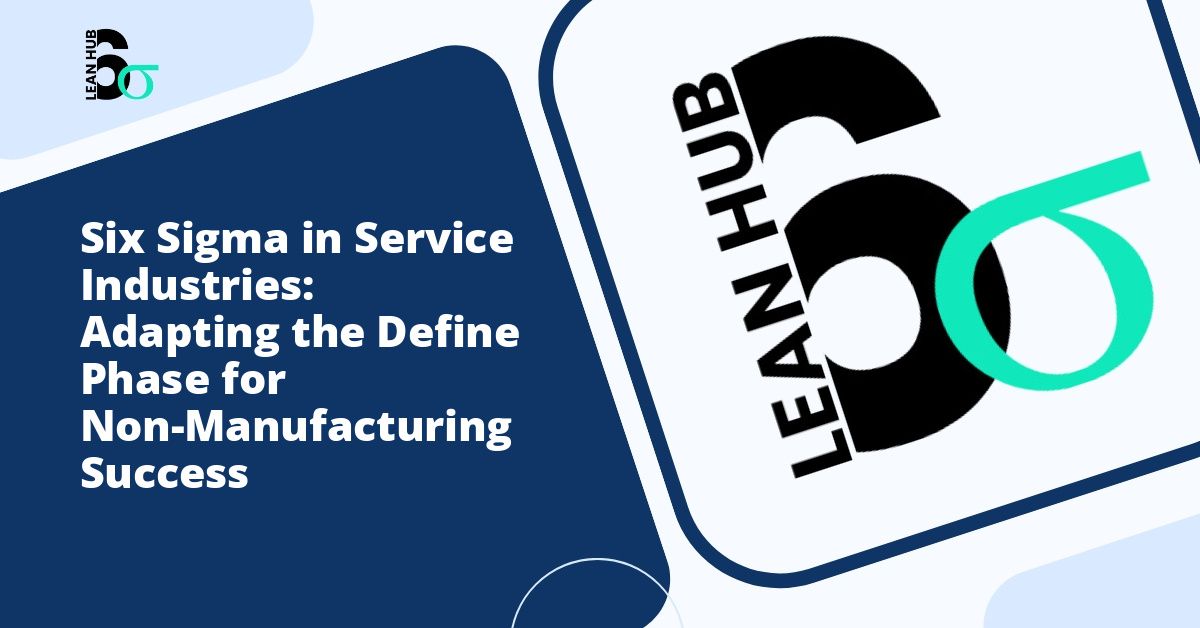The principles of Six Sigma have long been associated with manufacturing environments, where defects can be counted, processes measured, and quality improvements quantified with precision. However, service industries are increasingly discovering that these powerful methodologies can be adapted to drive significant improvements in their operations. The key lies in understanding how to properly modify the Define phase to suit the unique characteristics of service-based businesses.
Understanding Six Sigma Beyond Manufacturing
Six Sigma is a data-driven methodology designed to eliminate defects and reduce variation in processes. While its origins trace back to Motorola’s manufacturing operations in the 1980s, the fundamental principles of lean six sigma apply universally to any process that can be measured and improved. Service industries, including healthcare, banking, hospitality, insurance, and IT services, have successfully implemented these methodologies to enhance customer satisfaction, reduce costs, and improve operational efficiency. You might also enjoy reading about SIPOC Analysis Explained: Understanding Your Process at 30,000 Feet.
The challenge for service organizations lies not in whether Six Sigma can work, but in how to adapt its structured approach to environments where outputs are often intangible, customer interactions are complex, and processes involve significant human elements. The Define phase, being the foundation of any Six Sigma project, requires particular attention when transitioning from manufacturing to service contexts. You might also enjoy reading about How to Conduct Customer Interviews for Six Sigma VOC Analysis: A Complete Guide.
The Recognize Phase in Service Contexts
Before formally entering the Define phase, many service organizations benefit from an informal recognize phase where potential improvement opportunities are identified. This preliminary step is especially valuable in service industries because problems may not be as immediately visible as defective products on an assembly line. You might also enjoy reading about Manufacturing Six Sigma: Define Phase Best Practices for Production Processes.
During the recognize phase, service organizations should focus on identifying pain points through multiple channels. Customer complaints, employee feedback, operational metrics, and financial performance indicators all provide valuable signals about where processes are falling short. In a hospital setting, this might involve recognizing extended patient wait times. In banking, it could be identifying bottlenecks in loan application processing. For a hotel chain, it might mean recognizing inconsistencies in guest check-in experiences across different properties.
The recognize phase helps organizations prioritize which issues deserve the full rigor of a Six Sigma project. Not every problem requires this level of intensive analysis, so proper recognition and evaluation ensure resources are directed toward opportunities with the greatest potential impact.
Adapting the Define Phase for Service Industries
Establishing Clear Project Scope
In manufacturing, defining project scope might be straightforward: reduce defects in a specific product line by a certain percentage. In service industries, the scope requires more careful articulation because the “product” is often an experience or outcome rather than a physical item.
Service organizations must define their projects in terms of customer-facing processes and the specific aspects of service delivery they aim to improve. For example, rather than broadly stating “improve customer service,” a bank might define its project as “reduce the time required to open a new checking account from initial application to first transaction capability.” This specificity is crucial for maintaining focus throughout the project.
Identifying Stakeholders and Forming Teams
Service delivery typically involves more human interaction and cross-functional coordination than manufacturing processes. Therefore, the Define phase must carefully identify all stakeholders who influence or are affected by the process under examination.
In a healthcare setting, improving patient discharge processes might involve doctors, nurses, administrative staff, pharmacy personnel, billing departments, and insurance coordinators. Each group brings unique perspectives and constraints that must be considered. The project team should include representatives from these various functions to ensure comprehensive understanding and buy-in.
Developing the Problem Statement
A well-crafted problem statement in service industries must address the gap between current performance and desired outcomes while acknowledging the customer experience dimension. The statement should be specific, measurable, and focused on observable issues rather than assumed causes.
For instance, an insurance company might develop this problem statement: “Customer policy renewal completion currently takes an average of 12 days, resulting in a 15% abandonment rate and generating 200 customer service calls per month. Industry benchmarks suggest this process should take no more than 5 days.”
This statement quantifies the problem, indicates its impact, and establishes a benchmark for improvement without prescribing a solution.
Defining Customer Requirements and Critical-to-Quality Characteristics
Understanding the voice of the customer (VOC) is paramount in service industries, where customer perception often defines quality. The Define phase must include robust methods for capturing what customers actually value, which may differ significantly from what the organization assumes they want.
Service organizations should employ multiple VOC collection methods, including surveys, focus groups, complaint analysis, and direct observation. The challenge lies in translating qualitative customer feedback into quantifiable critical-to-quality (CTQ) characteristics that can be measured and improved.
For example, hotel guests might express a desire for “fast check-in.” Through further analysis, the organization might define this CTQ as “check-in process completed within 3 minutes for guests with reservations.” This translation from subjective customer language to measurable specifications is essential for lean six sigma success in service environments.
Creating the Project Charter
The project charter serves as the foundational document that authorizes the Six Sigma project and provides the team with clear direction. In service industries, this charter must address unique considerations such as employee engagement, customer communication, and the potential for service interruption during process changes.
A comprehensive service-oriented project charter should include the business case for the project, clear objectives with measurable targets, project scope and boundaries, team composition, timeline, required resources, and anticipated benefits. It should also address how service quality will be maintained during the improvement process, as service organizations typically cannot halt operations while implementing changes.
Common Challenges and Solutions
Measuring Intangible Outputs
One of the primary challenges in adapting Six Sigma to service industries is measuring outputs that are inherently intangible. Customer satisfaction, service quality, and experience cannot be measured with the same precision as physical defects.
The solution lies in developing proxy metrics that correlate with desired outcomes. These might include transaction completion times, error rates in documentation, customer callback frequency, or Net Promoter Scores. While not perfect measures, these proxies provide sufficient data for statistical analysis and improvement tracking.
Managing Process Variation
Service processes often involve high levels of variation because they depend on human judgment and customer-specific circumstances. A standardized approach to manufacturing may need significant adaptation to accommodate necessary flexibility in service delivery.
During the Define phase, organizations should distinguish between harmful variation that degrades service quality and beneficial variation that represents appropriate customization. The goal is not to eliminate all variation but to reduce unintended inconsistencies while preserving the ability to meet diverse customer needs.
Securing Leadership Support
Service improvement projects often require changes to customer-facing processes, which can create anxiety among staff and leadership. The Define phase must build a compelling business case that demonstrates how improvements will benefit customers, employees, and the organization’s bottom line.
Successful service organizations engage leadership early, present data-driven justification for the project, and establish clear governance structures that ensure adequate resources and remove obstacles as they arise.
Best Practices for Service Industry Define Phase
Organizations that have successfully implemented lean six sigma in service environments typically follow several best practices during the Define phase. First, they invest adequate time in the recognize phase to ensure they are addressing genuine problems with significant impact potential. Second, they prioritize projects that align with strategic objectives rather than pursuing improvements in isolation.
Successful service organizations also embrace technology as an enabler of measurement and monitoring. Process mining software, customer relationship management systems, and digital analytics platforms provide rich data sources that were previously unavailable, making Six Sigma applications in services increasingly feasible and effective.
Finally, leading service organizations maintain a customer-centric focus throughout the Define phase and beyond. They recognize that operational efficiency means little if improvements do not translate into enhanced customer value and satisfaction.
Conclusion
Adapting Six Sigma methodologies to service industries requires thoughtful modification of traditional manufacturing approaches, particularly during the critical Define phase. By properly recognizing improvement opportunities, carefully defining project scope, accurately capturing customer requirements, and developing appropriate measurement systems, service organizations can harness the power of lean six sigma to achieve breakthrough improvements.
The transition from manufacturing to service contexts is not merely about applying the same tools to different industries. It requires fundamental understanding of what makes service delivery unique and how systematic improvement methodologies can accommodate these differences while maintaining analytical rigor. Organizations that master this adaptation discover that Six Sigma principles are truly universal, capable of driving excellence wherever processes exist and measurement is possible.
As service sectors continue to dominate modern economies, the ability to adapt proven improvement methodologies becomes increasingly valuable. The Define phase, when properly tailored to service industry characteristics, establishes the foundation for successful projects that deliver measurable value to customers, employees, and stakeholders alike.








